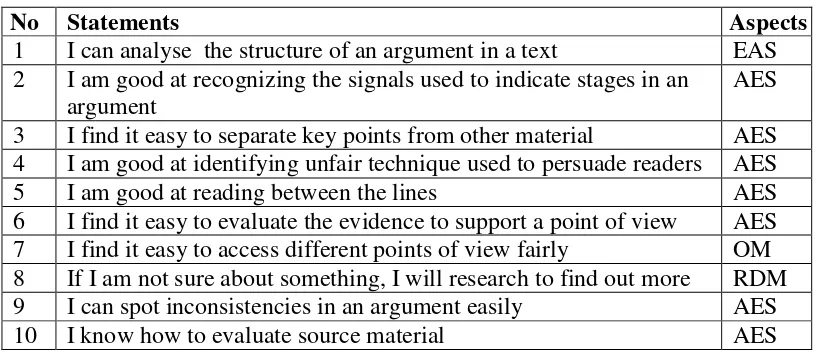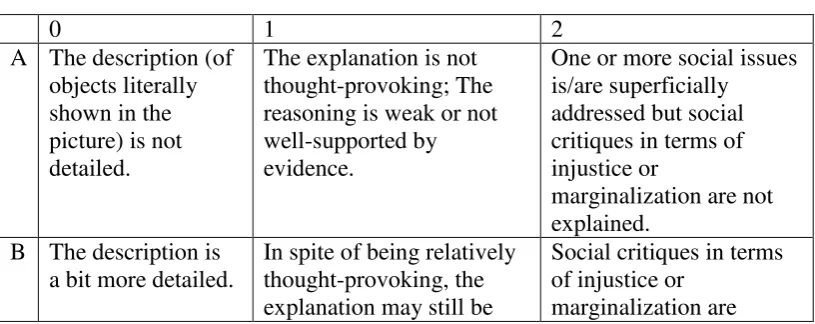CHAPTER III
METHODOLOGY
The purpose of this chapter is providing the information related to systematic activities accomplished in answering the research questions. To achieve that purpose, the third chapter is divided into four major sections. They are research questions, research design, data analysis, and conclusion. Each section will be described in the following paragraphs.
3.1. Research Questions
Considering the background and purposes of the study explained in the first chapter of this thesis, there are two research questions that are formulated in this study. They are:
1. How does the use of critical pedagogy principles in teaching EFL reading in tertiary level assist students to think critically?
2. What are the benefits and challengesof using the critical pedagogy principles in EFL reading class from the students’ perspective?
3.2. Research Design
In attempting to search the answers for the research questions, the present study applied a case study design. A case study is defined as an in-depth and detailed investigation of a case that could be a setting, a particular event, a subject, an ongoing process, or a document rather than a full numerical survey (Boglan & Biklen, 1992; Fraenkel et al., 2012). A case study was used as a consequence of this study trying to understand the detailed aspect of meaning and process of a particular phenomenon. A case study was selected as the research design also because of this study employed various data collection techniques and resources in seeking the depth and the comprehensiveness of understanding of the research context. This research was conducted in the form of teaching program.
3.2.1. Site and Participants
practice and develop dialogic education and democratic classroom after they become teachers in the future. In addition, it was selected because of accessibility and economical reasons. The site is near the place where researcher lives as near as from the university where researcher studies and meets his supervisors.
The group of participants was one of Reading in Professional Context classes consisted of 59 fourth semester students (13 male and 46 female) in English Education Department. The participants were 19-21 years of age. To pursue an in depth investigation and for the reason of time limitation in conducting the research, the present study only focused on 6 students (2 higher achievers, 2 medium achievers, and 2 other are lower achievers). The higher achievers had GPA more than 3.50. The medium achievers’ GPAs were less than 3.50 but more than 3.00. Meanwhile the GPAs of the lower achievers were less than 3.00. For the reason of ethical issue, the names of those six students are presented in pseudonyms.
3.2.2. Techniques of Collecting Data
The data collection techniques in this study were divided into two categories. They were the main and the supporting techniques. The main data collection techniques were observing classroom interactions and activities and distributing questionnaires. The supporting ones were conducting interview and gathering students’ learning journals. The various data collection techniques were employed in order to seek the rich data and to reduce the weaknesses possessed by each data collection technique (Yin, 2011; Alwasilah, 2012).
The sections below explain each of data collection techniques as well as instruments used in this study. In addition, the sources from which the data acquired using those strategies also included in each section.
3.1.2.1. Observation
specific, the observation focused on the dialogical processes in constructing textual meaning in classroom.
Two types of observation were employed in current research. They were overt non-participatory and covert non-participatory observations. An overt non-non-participatory observation was performed by a colleague who was in the same time conducting other research on critical literacy in the context of EFL secondary classroom. Meanwhile the covert participatory observation was executed by the researcher. Both observations were conducted to minimize researcher’s bias and in order to gain more valid and reliable data (Fraenkel et al., 2012). Furthermore, for the purpose of checking as well as avoiding misunderstanding the data from observations, classroom activities were recorded using video tape.
3.1.2.2. Questionnaire
Present study utilized both close-ended and open-ended questionnaires. The close-ended one, adapted from Cottrell (2007), was intended to uncover the level of CT possessed by the participants. This likert-scale questionnaire consists of ten statements that should be read, understood and responded by the participants based on their own awareness on their CT skills. Aspects of CT skills tried to investigate through questionnaire were analysis and evaluative skills (AES), open-mindedness (OM), and reasoned decision making (RDM). In order to question whether there was an improvement of participants’ CT, the questionnaire was distributed before and after the program. Table 3.1 follow describes the statements and the aspect of CT skills questioned.
Table 3.1 Self-evaluation critical thinking skills questionnaire
No Statements Aspects
1 I can analyse the structure of an argument in a text EAS 2 I am good at recognizing the signals used to indicate stages in an
argument
AES 3 I find it easy to separate key points from other material AES 4 I am good at identifying unfair technique used to persuade readers AES
5 I am good at reading between the lines AES
6 I find it easy to evaluate the evidence to support a point of view AES 7 I find it easy to access different points of view fairly OM 8 If I am not sure about something, I will research to find out more RDM 9 I can spot inconsistencies in an argument easily AES
10 I know how to evaluate source material AES
challenges perceived by each participant. To put it in detail, this open-ended questionnaire consists of four points questioning students’ opinions about the meaning of CT for each of them, how the program assisted them to think critically, benefits they have got after joining the program, and challenges they faced when attending the class.
3.1.2.3. Learning Journal
After attending each meeting, the participants were required to write reflective learning journals about their interest and difficulty (Emilia, 2005) in English. Learning journals were also expected to provide the researcher with information about the indication of participants’ CT skills such analysis and evaluative skills, open-mindedness and suspended decision making skill (Norris & Ennis, 1990). In writing their learning journals, the participants were guided by the format that was established before. The learning journal format generally consists of what the students have known about the topic discussed in particular meeting, what the students get from classroom teaching learning activities, and what students want to know further after attending the class relating topic discussed in particular meeting.
3.1.2.4. Interview
The type of interview employed in this study was a semi-structured that was conducted once in the end of the program. Its purposes were confirming, supporting and comparing as well as intensifying the researcher’s understanding toward what had been collected using learning journals, questionnaires and classroom observations. Moreover, it also aimed at revealing the participants’ responses toward the overall program. The interview was also conducted to facilitate students to raise their awareness towards what they have gained from the teaching program. The interview guidelines, consisted of 14 questions, were adapted from Emilia (2005) and Gustine (2014). Six participants were chosen to be interviewed consisted of two high achievers, two averages, and two others low achievers.
3.3. Data Analyses
the rests were analyzed after the data had been collected. The following sub-sections elaborate how the collected data using each data collection technique were analyzed.
3.3.1. Observation
The frist steps taken in analysing the data from classroom observation were rewriting the observers’ and reserachers’ notes as well as transcribing the video tape recordings. The transcriptions and the rewritten notes were then analyzed through identifying and highlitghting classroom talks and activities that represented the sutdents’ critical thinking skills performances and the implementation of critical pedagogy principles. Table 3.2 Below describes the codings employed to transcribe recordings in current research.
Table 3.2 Codings
In analysing classroom talks, turn taking and the complexity of stucture and content of students’ utterances were analyzed to investigate the critical moments occurred in the classroom. In order to assess and identify the degree of criticality and descriptions of students’ talks about codes and written texts, present research adopts an axial coding rubric established by Mambu (2009: 65). Here is the brief delineation of that rubric:
partial or trapped in logical criticality. In assessing the depth of students’ talks, ‘A’ demonstrates the poor description (for ‘0’) low criticality (for ‘1’ and ‘2’). ‘B’ means the average description or criticality. And ‘C’ shows the good description or deep degree of criticality.
The analysis were also performed by thematically separating and categorizing tehacer-students talks portion and students’ responses toward teachers’ and other students’ questions based on similarity, diference, and frequency of accurance. The analysis results were then compared between the data from observer, resracher, and video tape recordings to find out the evidence for critical moments as well as students’ involvement, cooperation, enthusiasm and improvement in joining the program in each meeting.
3.3.2. Questionnaire
3.3.3. Learning Journal
Data from learning journals were analyzed by hihglighting and categorizing the identical students’ writings to indentify reflective comments and responses including difficulties they faced in every meeting. Students’ CT skills were also reflected in their learning journals. It could be identified from content and structure of their writing whether they put arguments for their claims or not. Those data were then interpreted in aswering the research questions.
3.3.4. Interview
The interview data were analyzed in several identical sequential steps in order to answer both first and second research queries. Those are transcribing, coding, condensing, categorizing, and interpreting. The recorded interviews were transcribed to get the precise and more accurate data. Categorization was executed thematically by considering the importance, frequency, repetition, keywords in contexts, and similarity and difference based on the research questions and framed by the theories in chapter two. In interpretation step, the data were related and compared with the theories and previous studies.
3.3.5. Triangulation
Validity is a crucisl issue in qualitative research. In order to make sure that the research is valid and trustworthy, triangulation was performed in present study. In current research, it was carried out through executing three activities. Firstly, the data were accumulated using different data collection techniques (Alwasilah, 2012). Secondly, by comparing accumulated data from different data resources and data colecction techniques. The purpose of comparison was to find out the existance of consistency and inconsistency between the assembled data (Emilia, 2012). Lastly, triangulation was also accomplished throughout involving a colleague to observe the teaching program (Fraenkel et al., 2012) in order to minimize the researcher’s bias.
3.4. Conclusion of the Chapter Three

